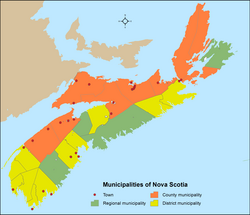
Back Seznam měst v Novém Skotsku Czech Liste der Gemeinden in Nova Scotia German Luettelo Nova Scotian kunnista Finnish Liste des municipalités de la Nouvelle-Écosse French Lijst van plaatsen in Nova Scotia Dutch Lista de municípios da Nova Escócia Portuguese Listă de localități din Noua Scoție, Canada Romanian List of municipalities in Nova Scotia SIMPLE 新斯科舍省社区列表 Chinese


Nova Scotia is the seventh-most populous province in Canada with 969,383 residents as of the 2021 Census of Population, and the second-smallest province in land area at 52,824.71 km2 (20,395.73 sq mi).[1] Nova Scotia's 49 municipalities cover 99.8% of the territory's land mass, and are home to 98.7% of its population.[a][2]
Unlike the provinces of British Columbia, Ontario and Quebec, which have two-tiered municipal systems, Nova Scotia has a one-tier system of municipalities[3] inclusive of four municipality types – regional municipalities, towns, county municipalities and district municipalities.[4] Regional municipalities may incorporate under the Municipal Government Act (MGA) of 1998, which came into force on April 1, 1999,[5] while towns, county municipalities and district municipalities are continued as municipalities under the MGA.[6] The MGA gives municipal councils the power to make bylaws for "health, well being, safety and protection of persons" and "safety and protection of property" in addition to a few expressed powers.[7]
Of its 49 municipalities, Nova Scotia has 4 regional municipalities, 25 towns, 9 county municipalities and 11 district municipalities.[4][8] The regional municipality of Halifax is the capital and largest municipality of Nova Scotia by population with 439,819 residents representing 45% of the total population of the province and land area at 5,475.57 km2 (2,114.13 sq mi).[2] Pictou was the first municipality to incorporate May 4, 1874,[9] and the newest municipality is West Hants Regional Municipality that incorporated through an amalgamation of the Municipality of the District of West Hants and the Town of Windsor on April 1, 2020.[8]
- ^ "Population and dwelling counts, for Canada, provinces and territories, 2021 and 2016 censuses – 100% data". Statistics Canada. March 14, 2022. Retrieved March 14, 2022.
- ^ a b c Cite error: The named reference
2021censuswas invoked but never defined (see the help page). - ^ Gonzalo Pineros (2015). "Upper Tier and Lower Tier Municipality Integration to Collaboratively Address Population Growth, Aging Infrastructure and Climate Change" (PDF). McMaster University. p. 7. Retrieved December 28, 2016.
The Canadian provinces of Ontario, Quebec and British Columbia have two-tier municipality systems.
- ^ a b Cite error: The named reference
2015MuniStatswas invoked but never defined (see the help page). - ^ "Municipal History Highlights". Province of Nova Scotia Department of Municipal Affairs. October 8, 2015. Retrieved December 8, 2016.
- ^ "Municipal Government Act" (PDF). Office of the Legislative Counsel, Nova Scotia House of Assembly. June 19, 2012. Retrieved December 5, 2016.
- ^ "Assessment of the Municipal Acts of the Provinces and Territories" (PDF). Federation of Canadian Municipalities. April 2004. p. 30. Retrieved December 5, 2016.
- ^ a b Cite error: The named reference
WestHantswas invoked but never defined (see the help page). - ^ Cite error: The named reference
incorporationswas invoked but never defined (see the help page).
Cite error: There are <ref group=lower-alpha> tags or {{efn}} templates on this page, but the references will not show without a {{reflist|group=lower-alpha}} template or {{notelist}} template (see the help page).
© MMXXIII Rich X Search. We shall prevail. All rights reserved. Rich X Search